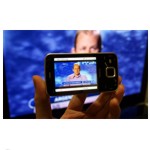 The nation’s two largest telecom service providers AT&T and Verizon have considerably different views on consumer video opportunities, as illustrated today by comments made by AT&T Chairman and Chief Executive Officer Randall Stephenson and Verizon Executive Vice President and Chief Financial Officer Fran Shammo at the Wells Fargo Tech, Media & Telecom Conference in New York today (also webcast).
The nation’s two largest telecom service providers AT&T and Verizon have considerably different views on consumer video opportunities, as illustrated today by comments made by AT&T Chairman and Chief Executive Officer Randall Stephenson and Verizon Executive Vice President and Chief Financial Officer Fran Shammo at the Wells Fargo Tech, Media & Telecom Conference in New York today (also webcast).
AT&T Vs. Verizon Video Strategy
AT&T is hoping its impending acquisition of DirecTV will give it the scale to make its U-verse video offerings profitable–which, according to Stephenson, is not currently the case. A linear video offering is essential to gaining broadband subscribers but “when you’re sub-scale, content costs eat up all the margins,” said Stephenson.
DirecTV’s national footprint, in combination with AT&T’s national wireless footprint, also should help the combined company gain mobile video rights from content providers, Stephenson argued.
Shammo disagreed. Noting that there is a “perception that if you have a great relationship in linear, you will have a better [relationship] in wireless,” he said, “we view it as two different opportunities.”
Verizon is the only company to have wireless rights to video that aren’t pinned to a linear video subscription, Shammo said. He also noted that the company sees an opportunity to use multicast technology to deliver live events such as concerts “extremely efficiently.”
Net Neutrality and More
Stephenson and Shammo also had interesting observations about Net Neutrality, the connected car, and symmetrical broadband service:
- AT&T upped the ante on the Net Neutrality debate, with Stephenson telling conference attendees that the company has put gigabit deployment plans on “pause” as a result of President Obama’s proposal this week to reclassify broadband as a telecommunications service.
- Verizon sees an opportunity to deliver customer service and other support for the connected car — something the company already is offering Mercedes. While the connectivity underlying connected car offerings might generate fifty cents in monthly revenue per car, the support opportunity could generate $20 to $30 a month, Shammo said. “With this platform we can go outside the U.S. and not necessarily be the network provider,” he added.
- Expect Verizon to continue to tout its symmetrical Quantum broadband service. Shammo said Verizon is the only major network operator that can offer symmetrical service because its FiOS service is based on fiber-to-the-home. The company has previously noted that this provides an edge against cable companies that rely on HFC infrastructure. But Shammo’s comments appeared to be directed at AT&T, which with few exceptions relies on high-speed DSL for its U-verse offering.


